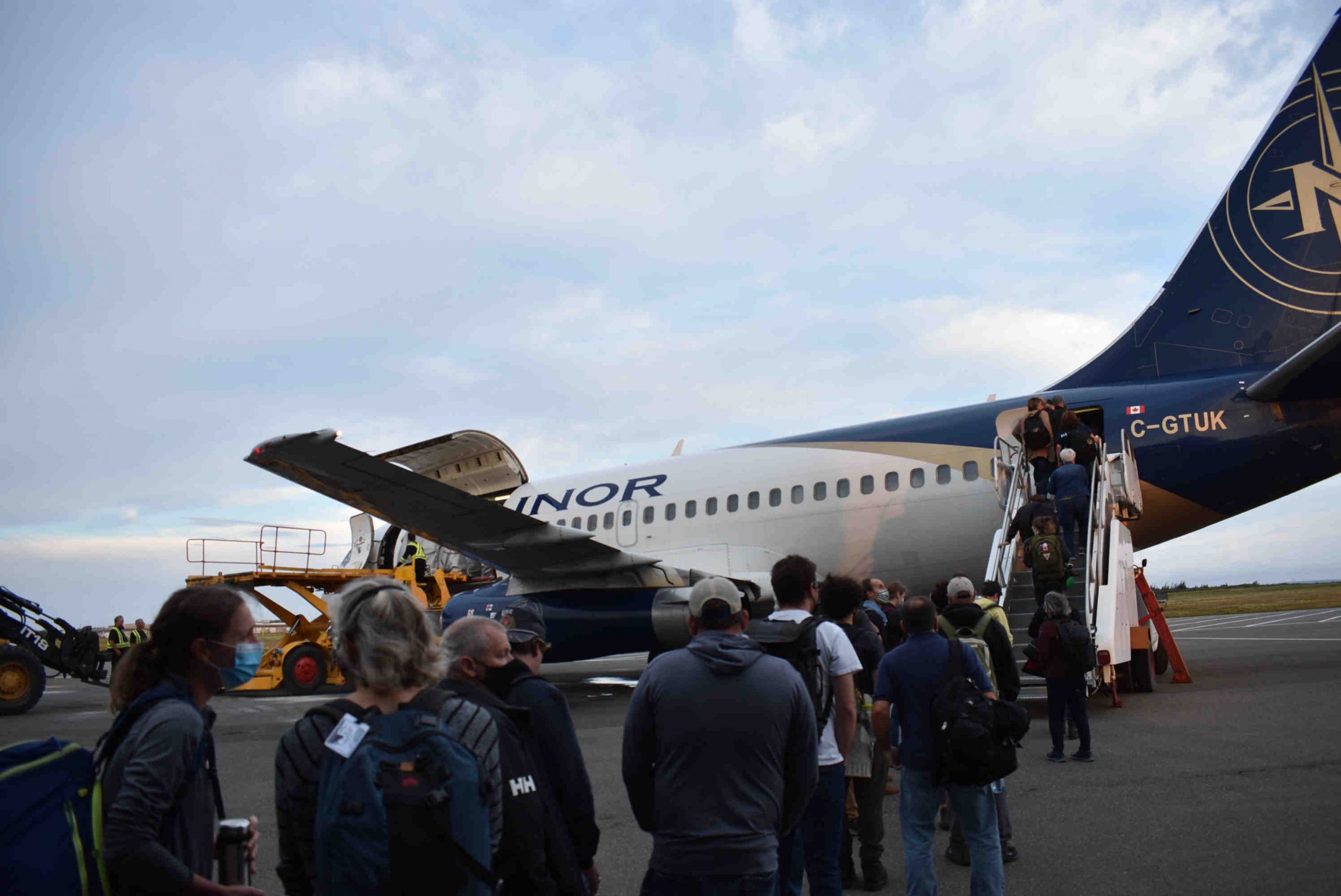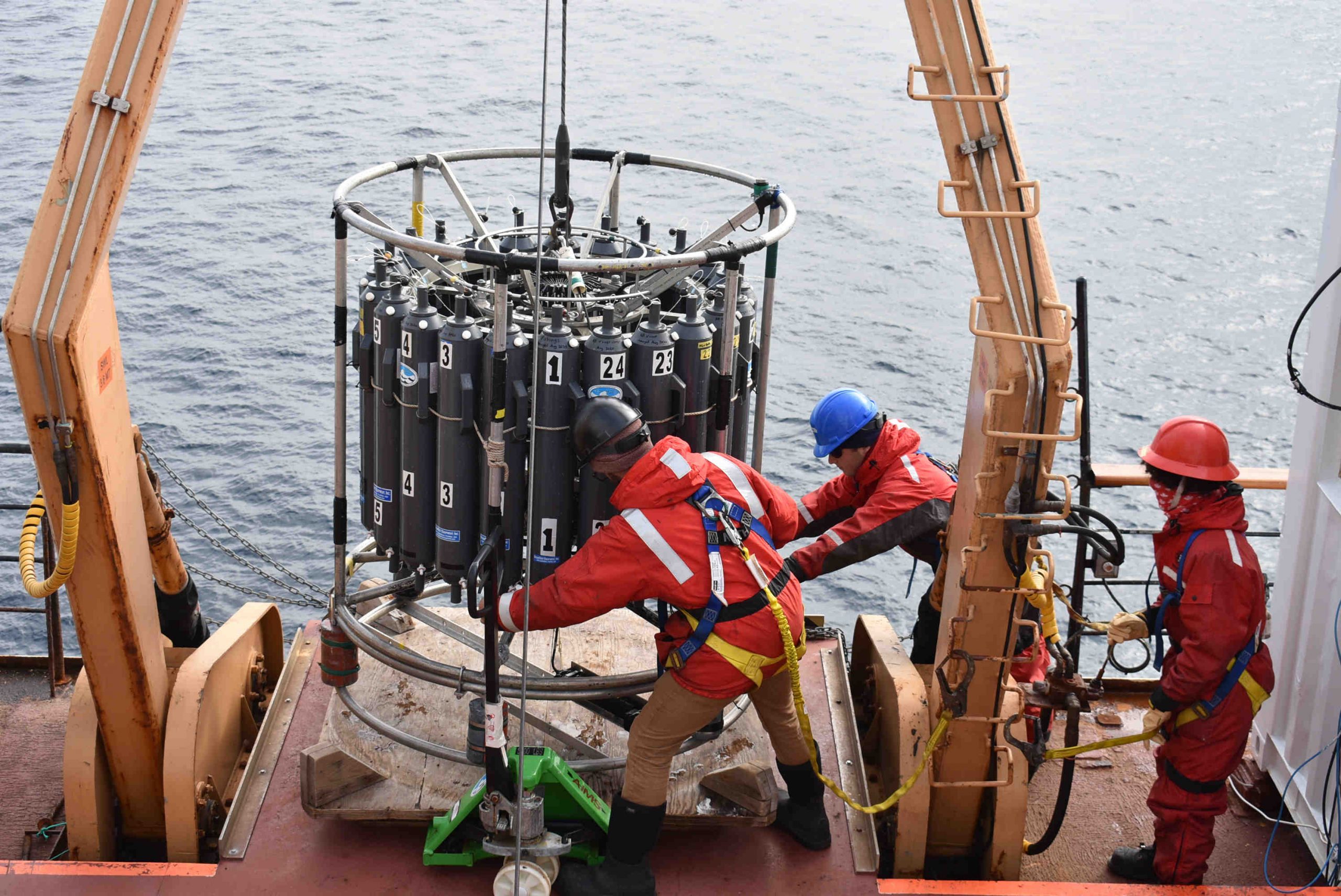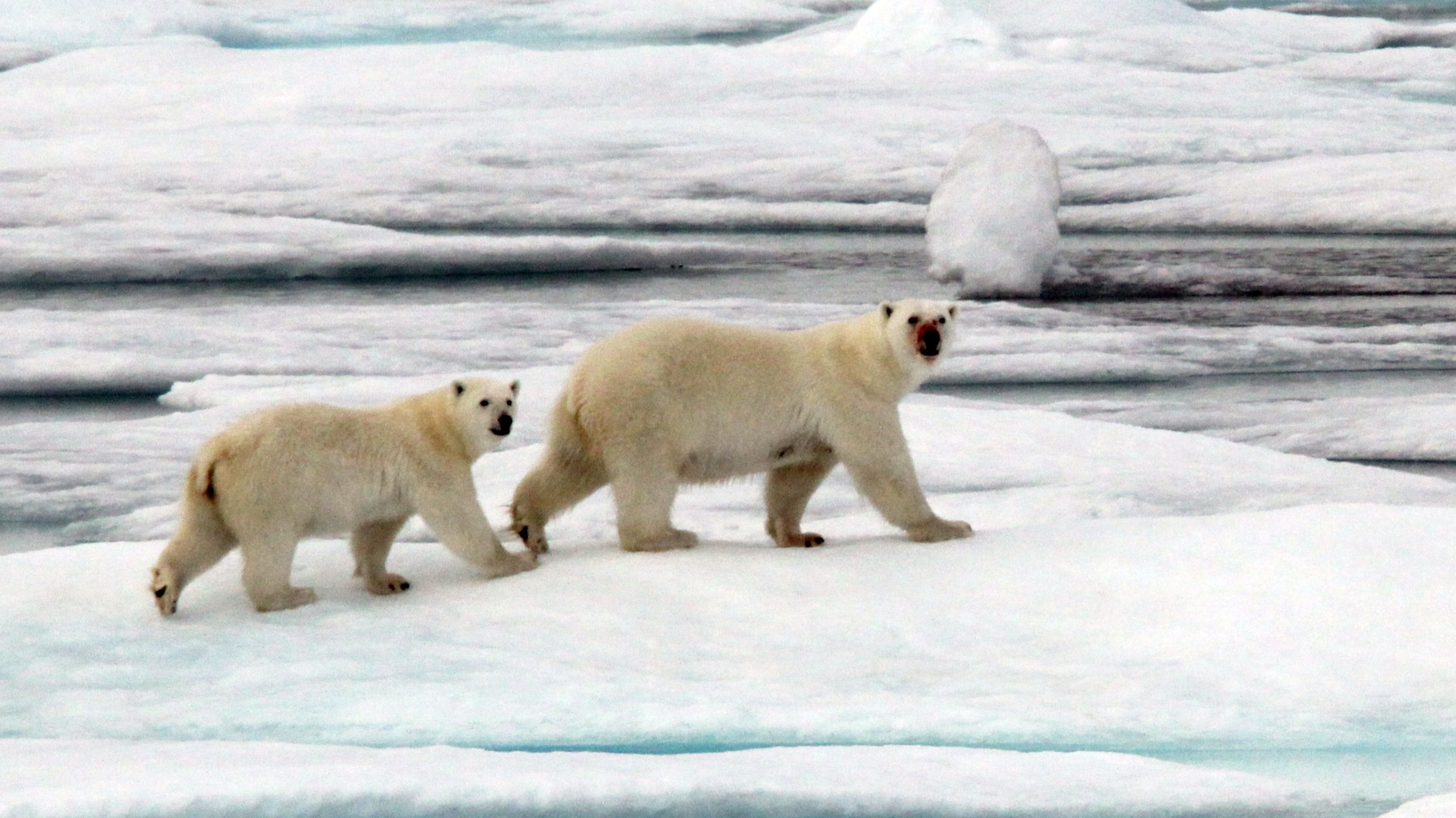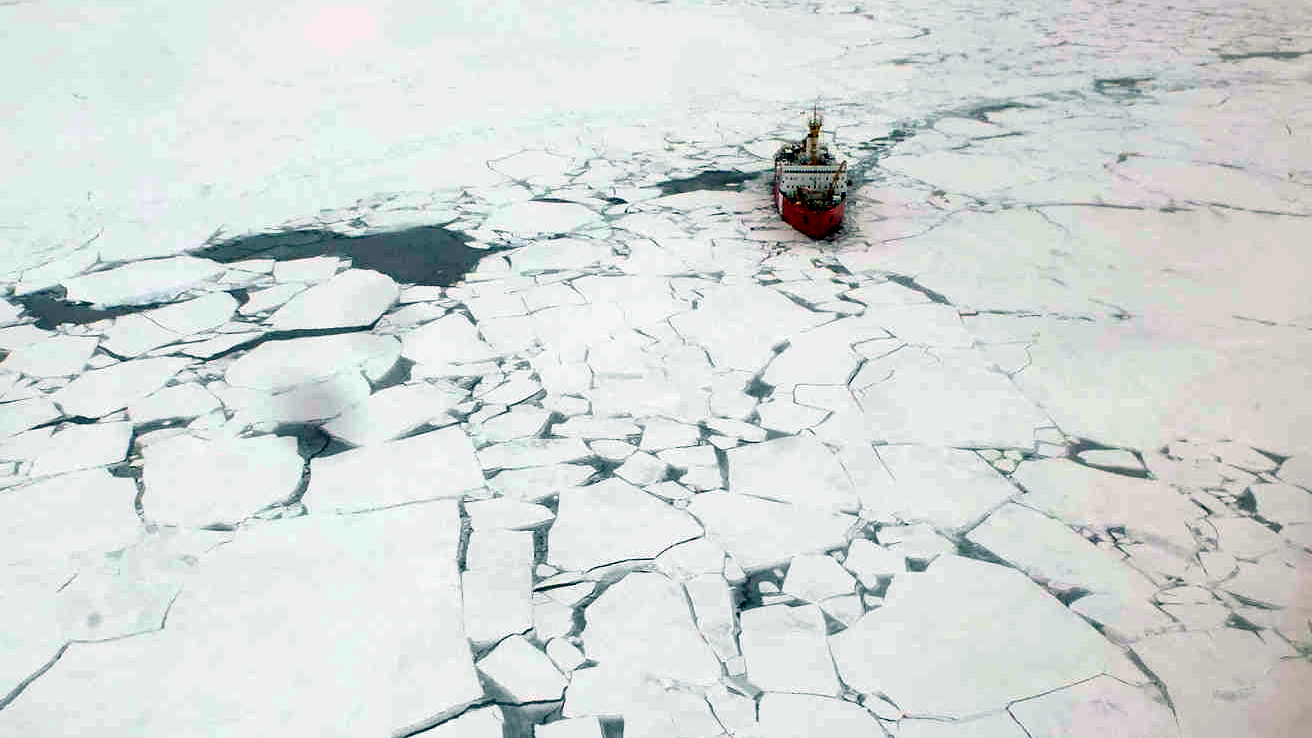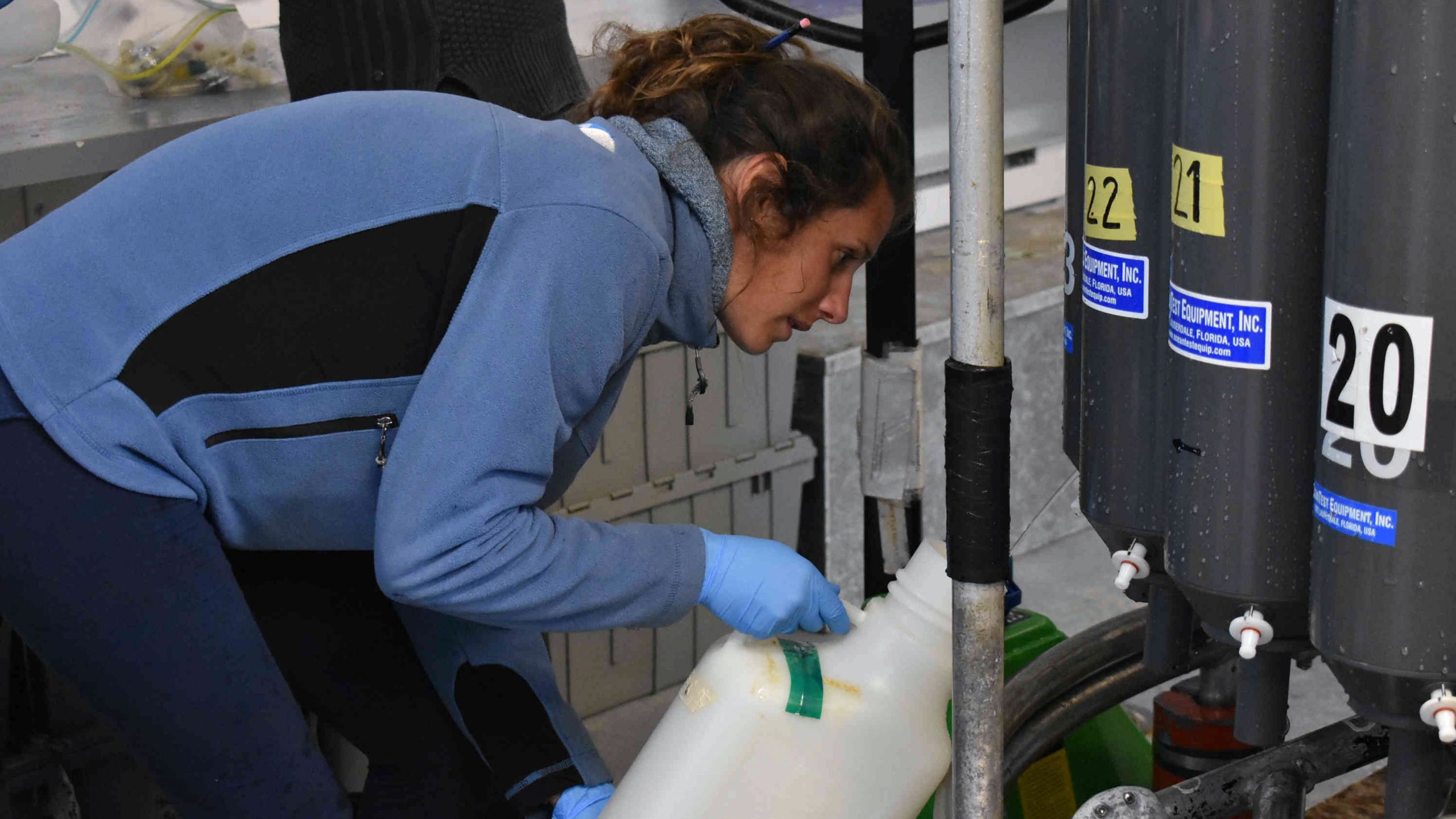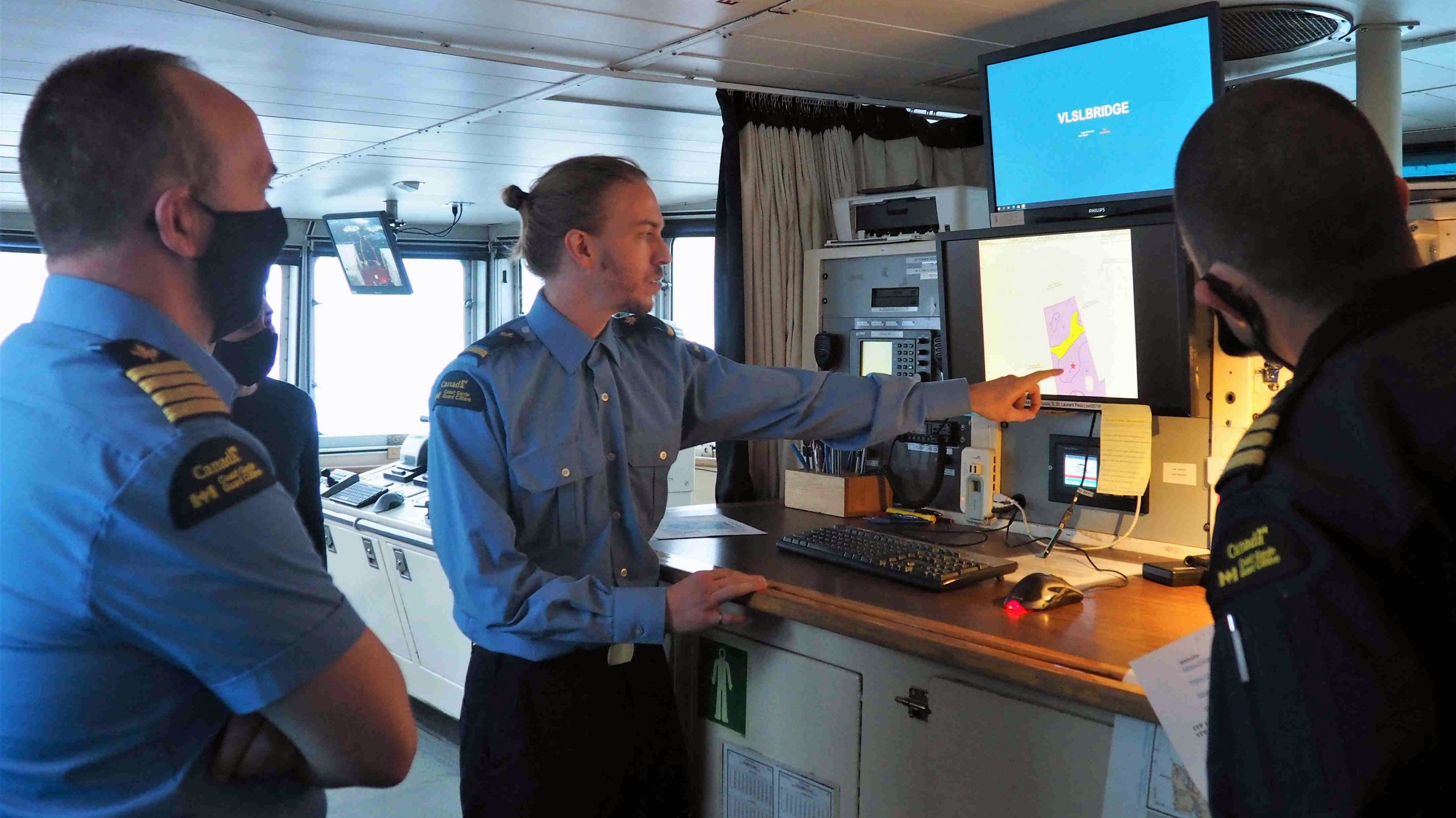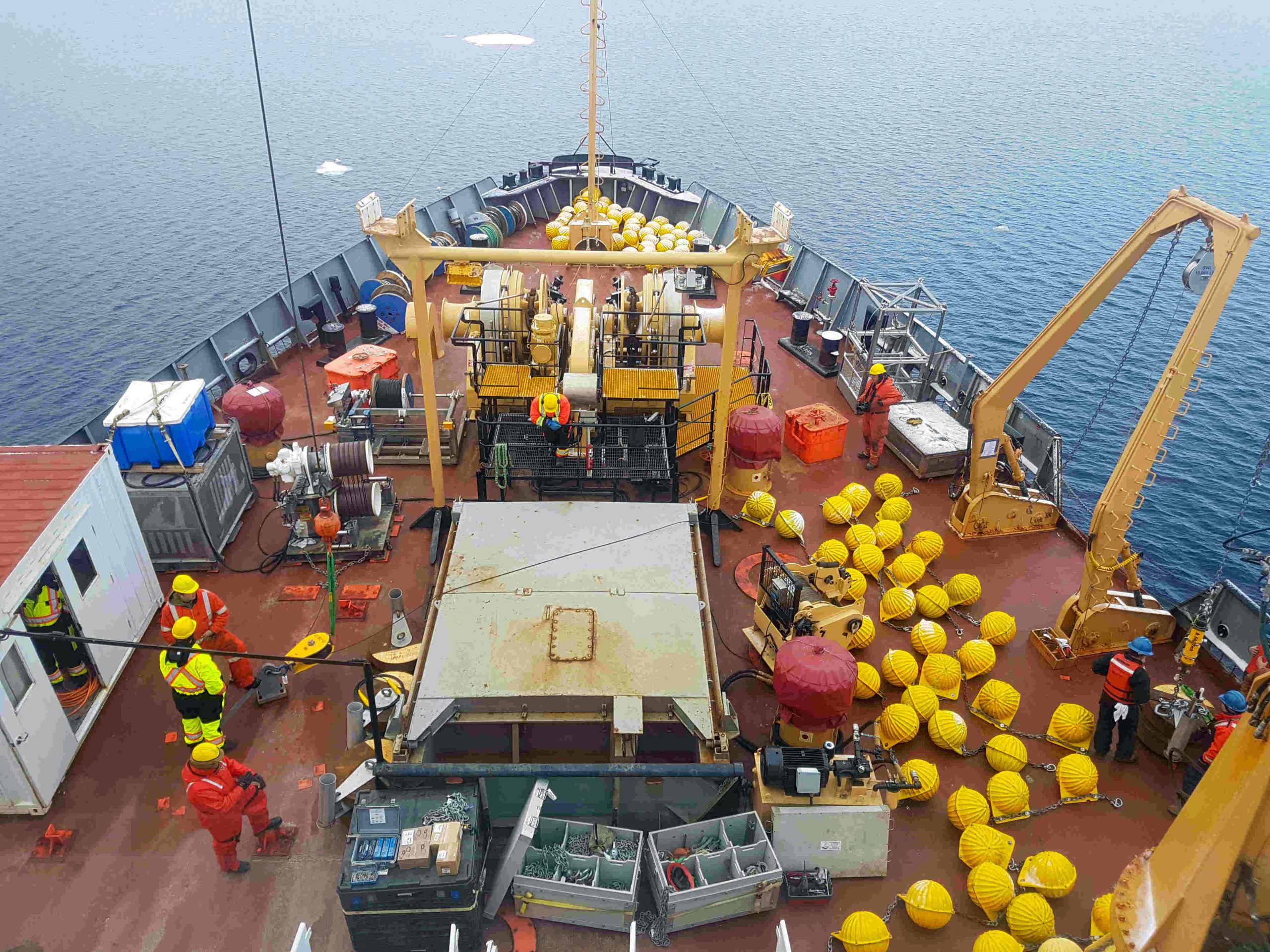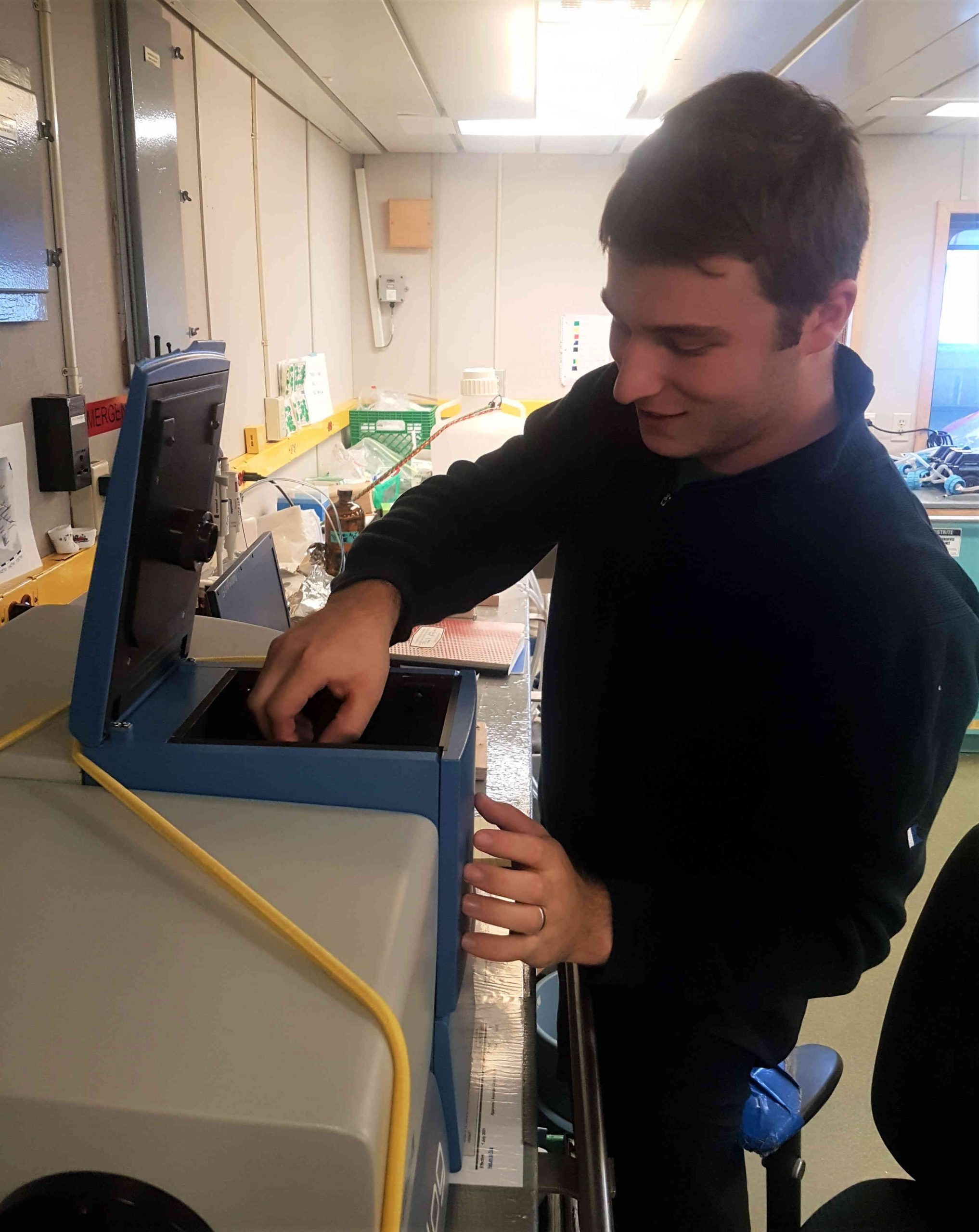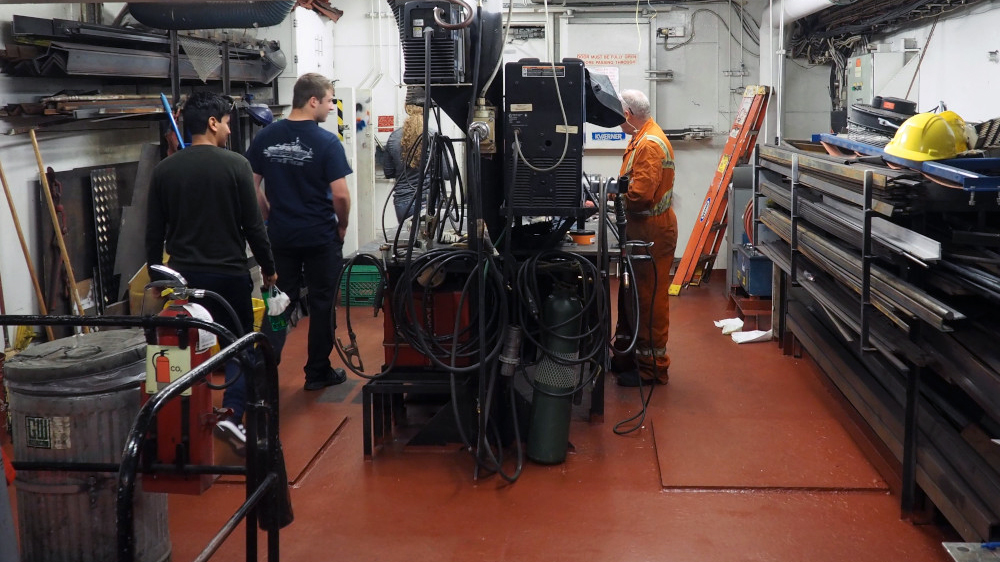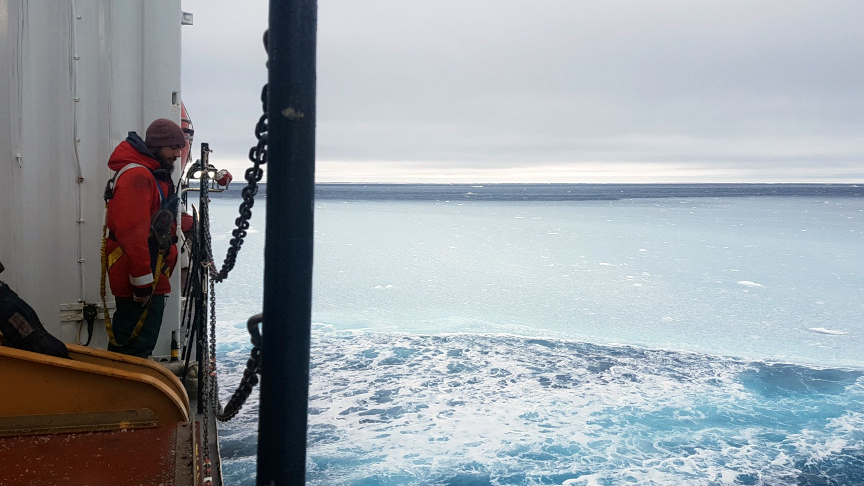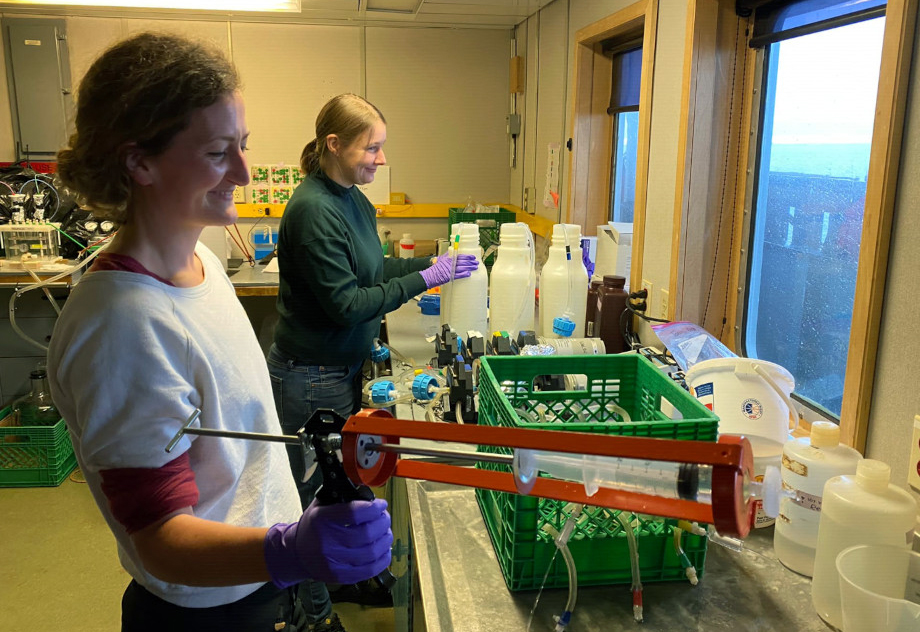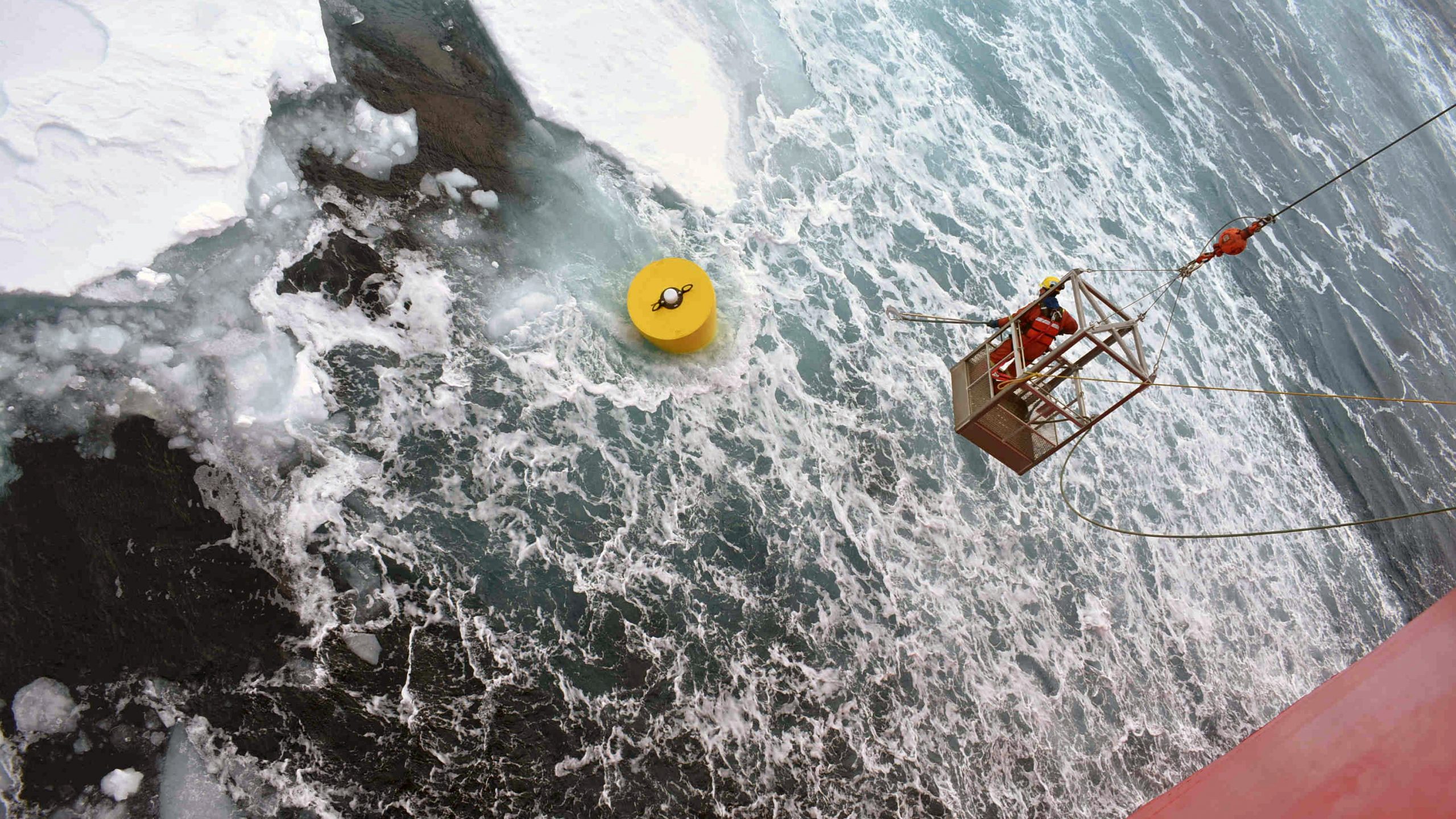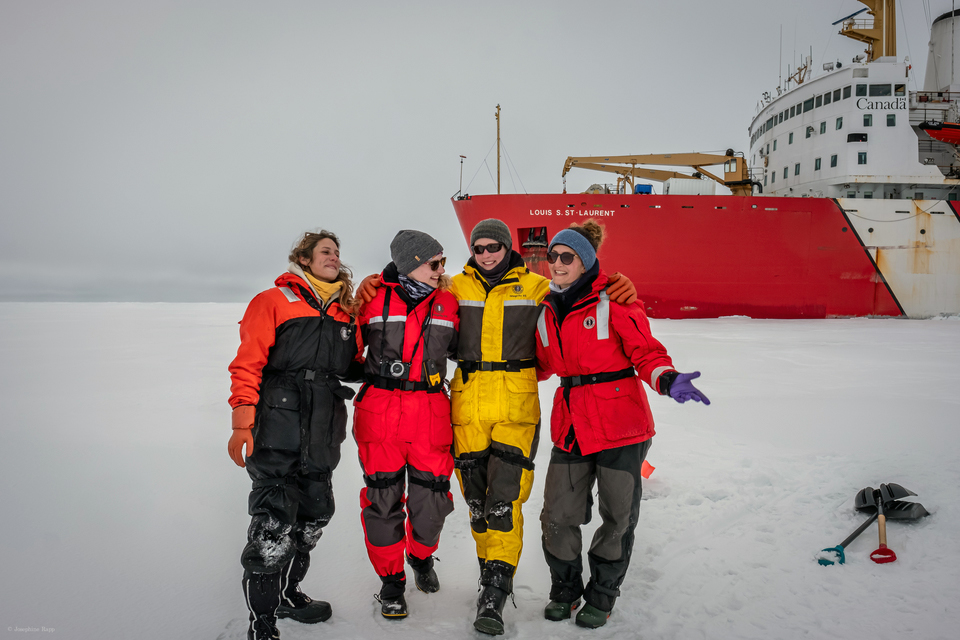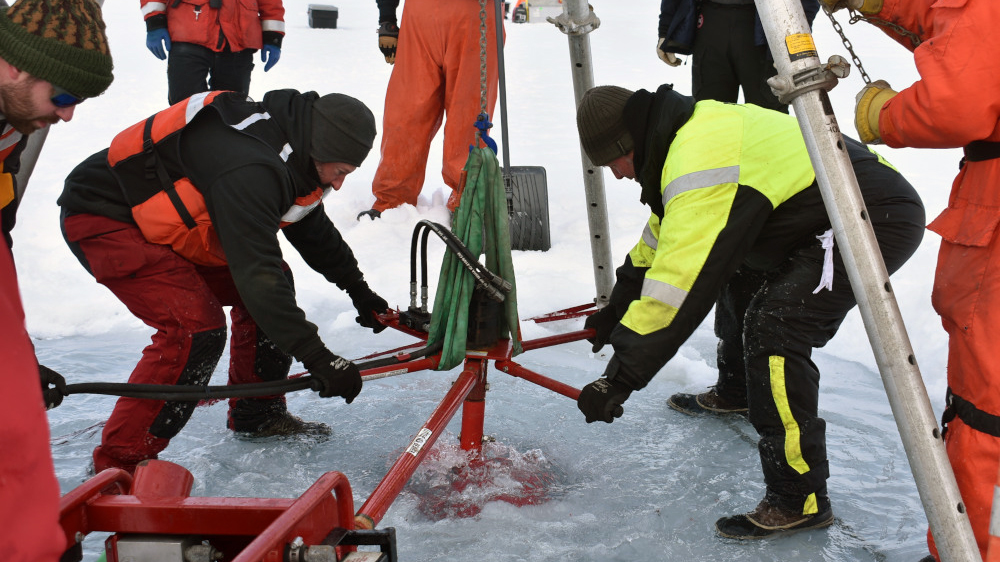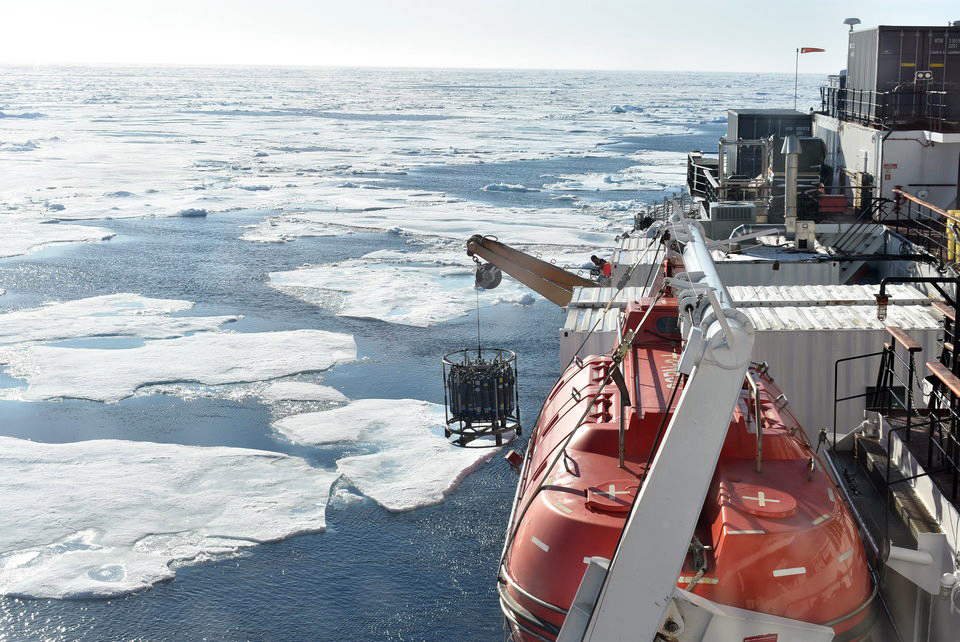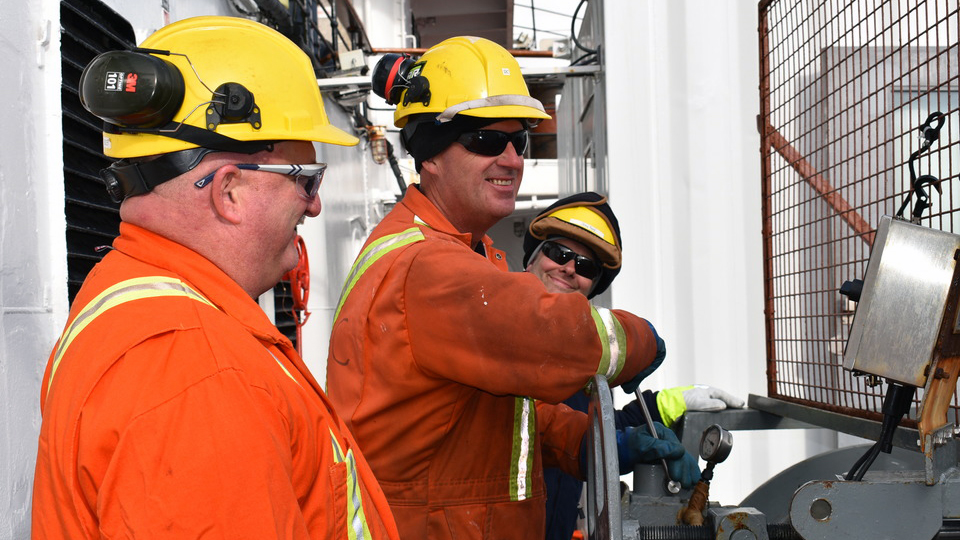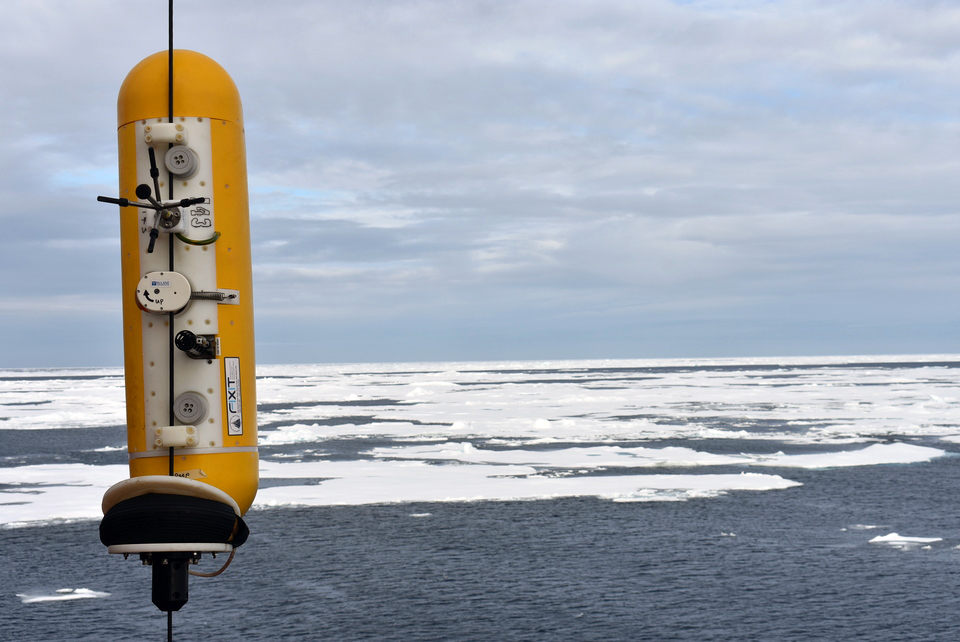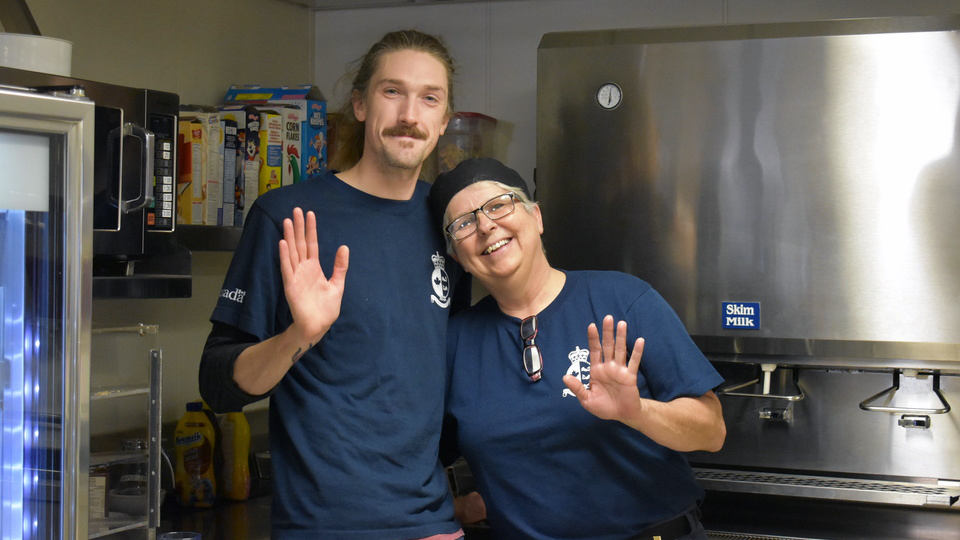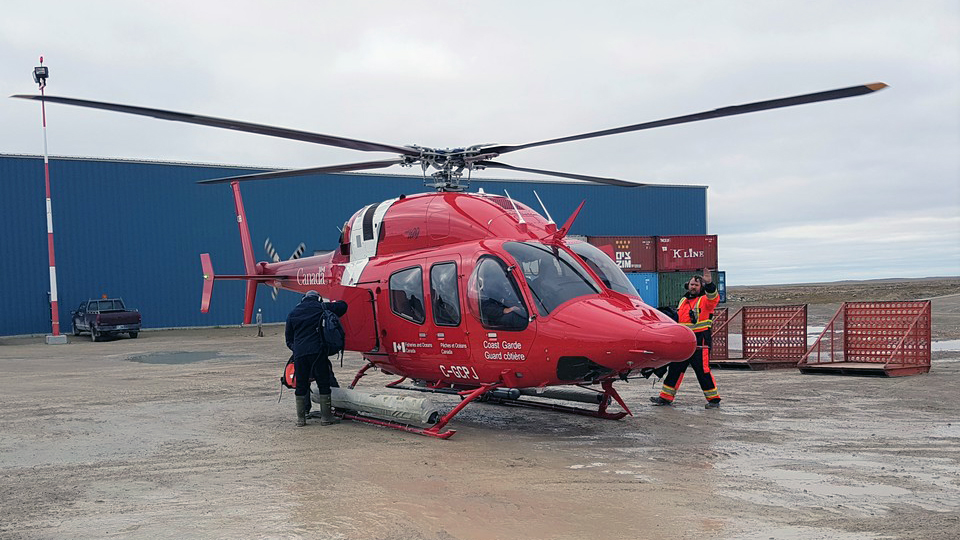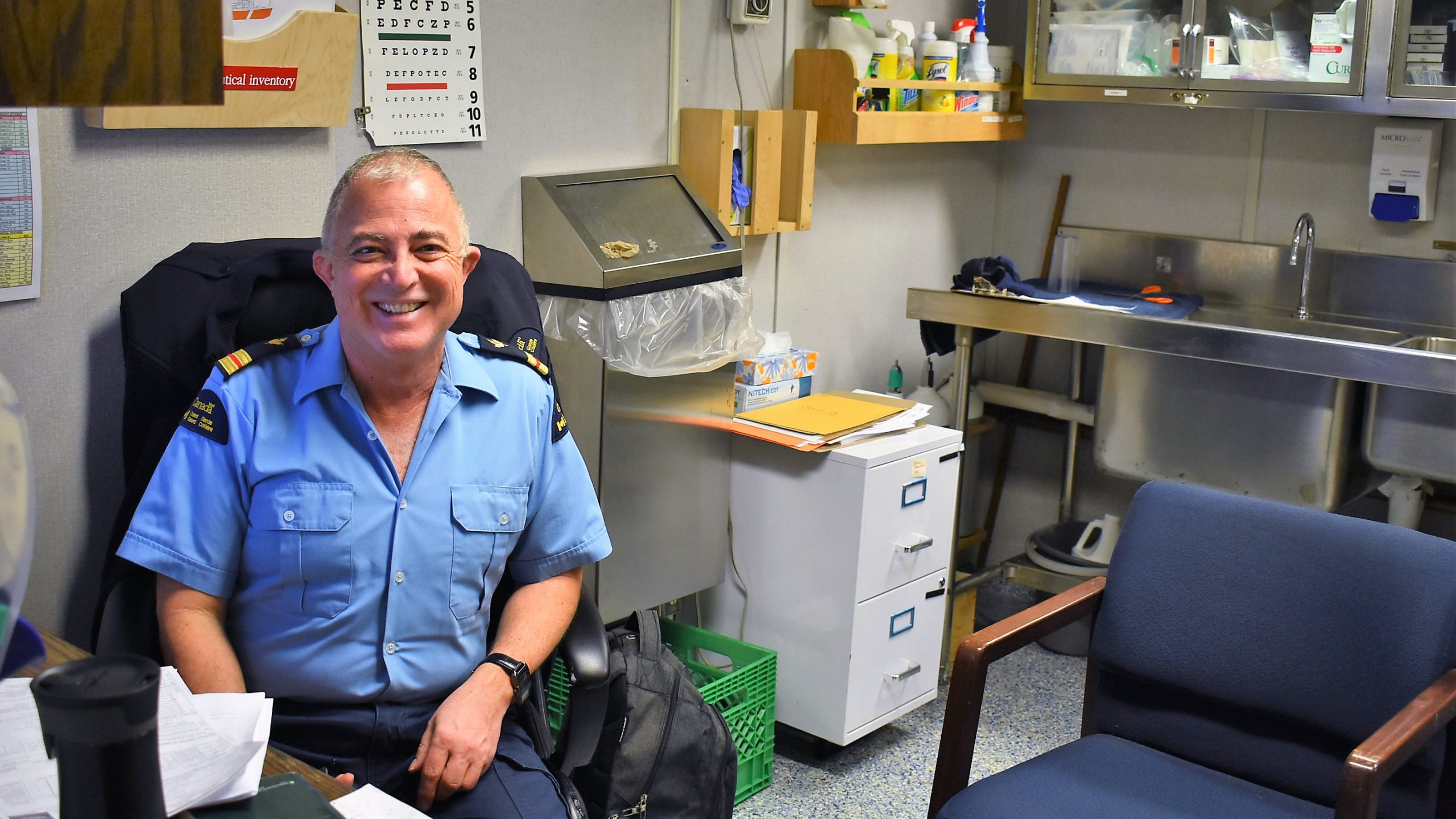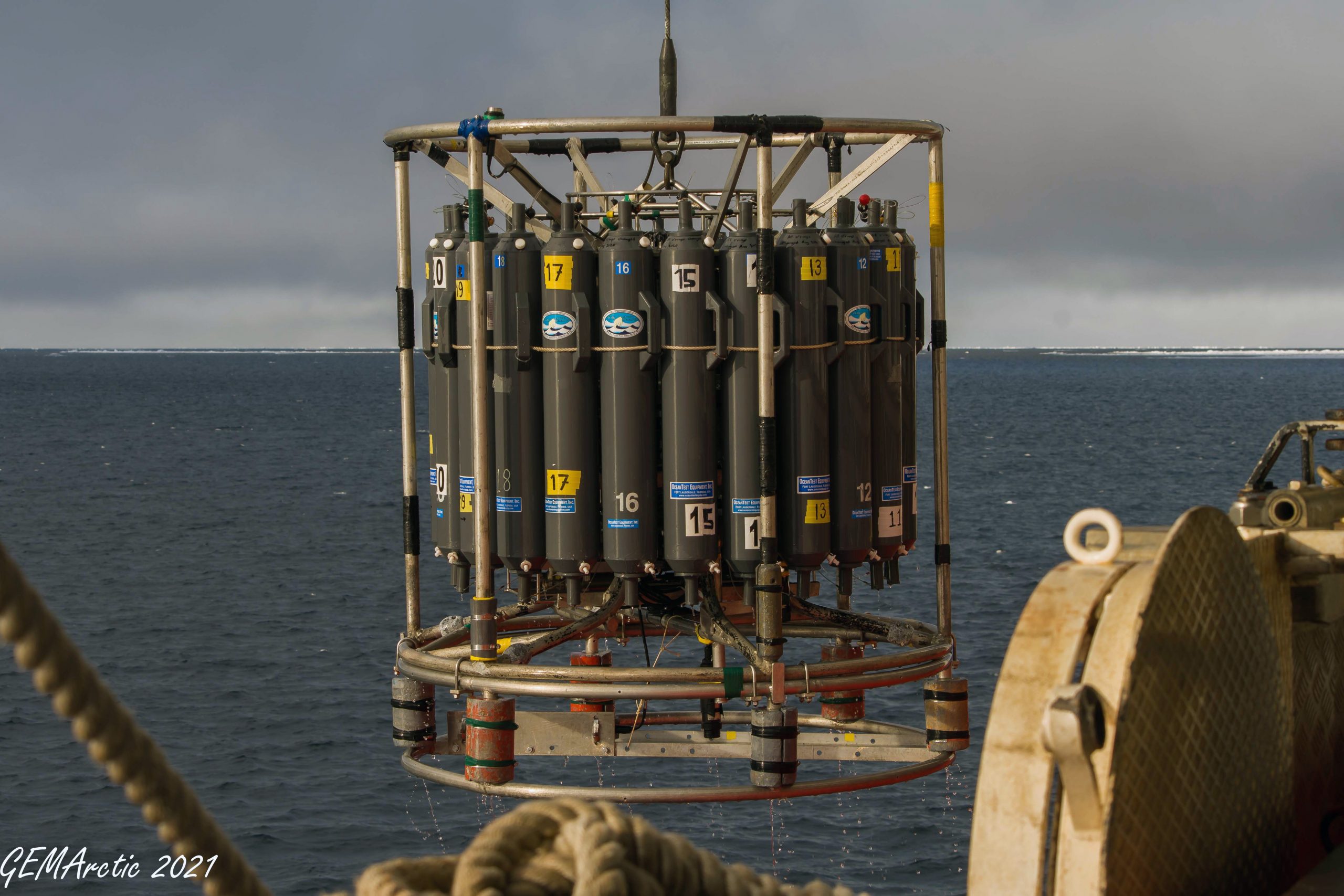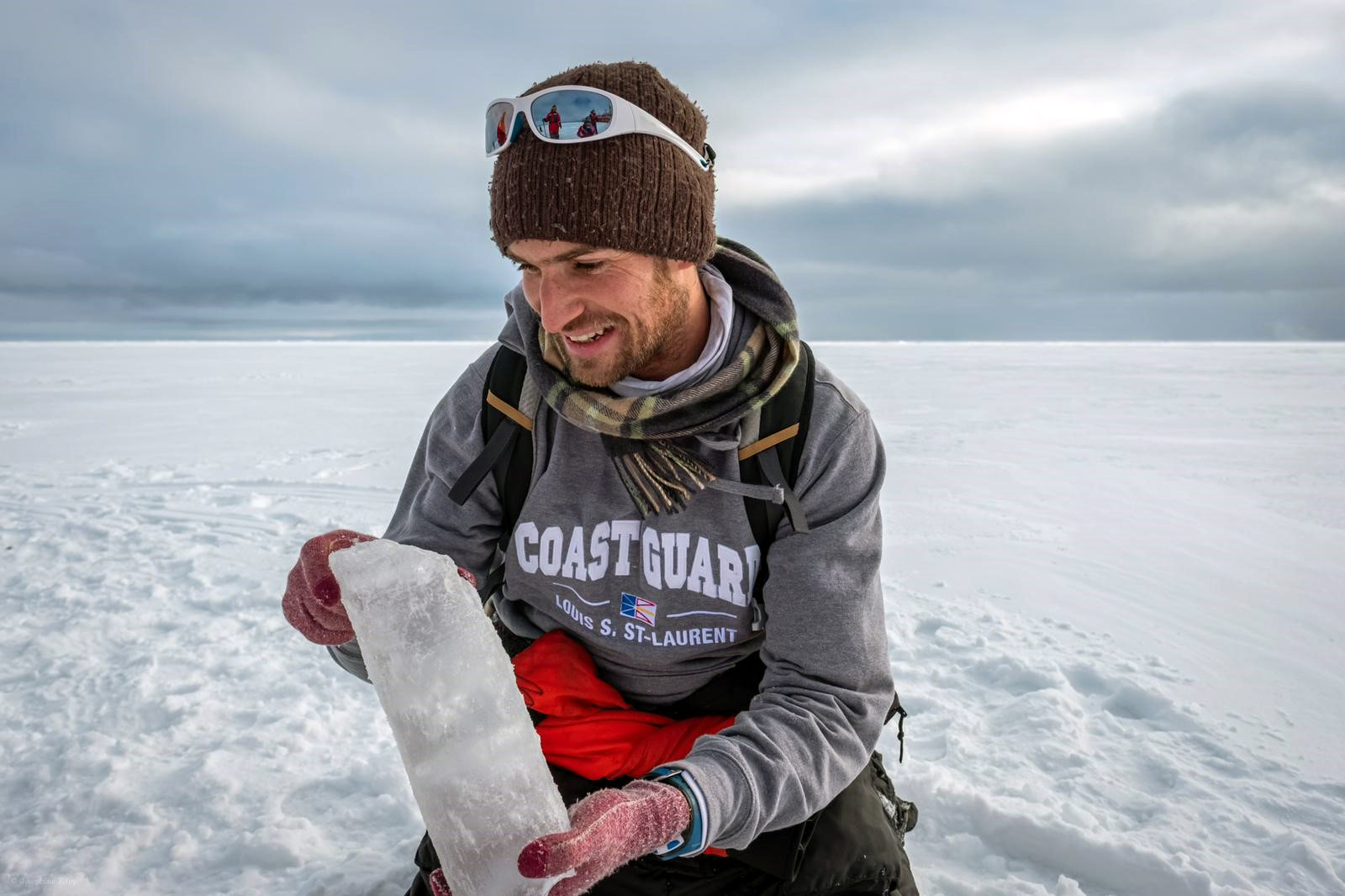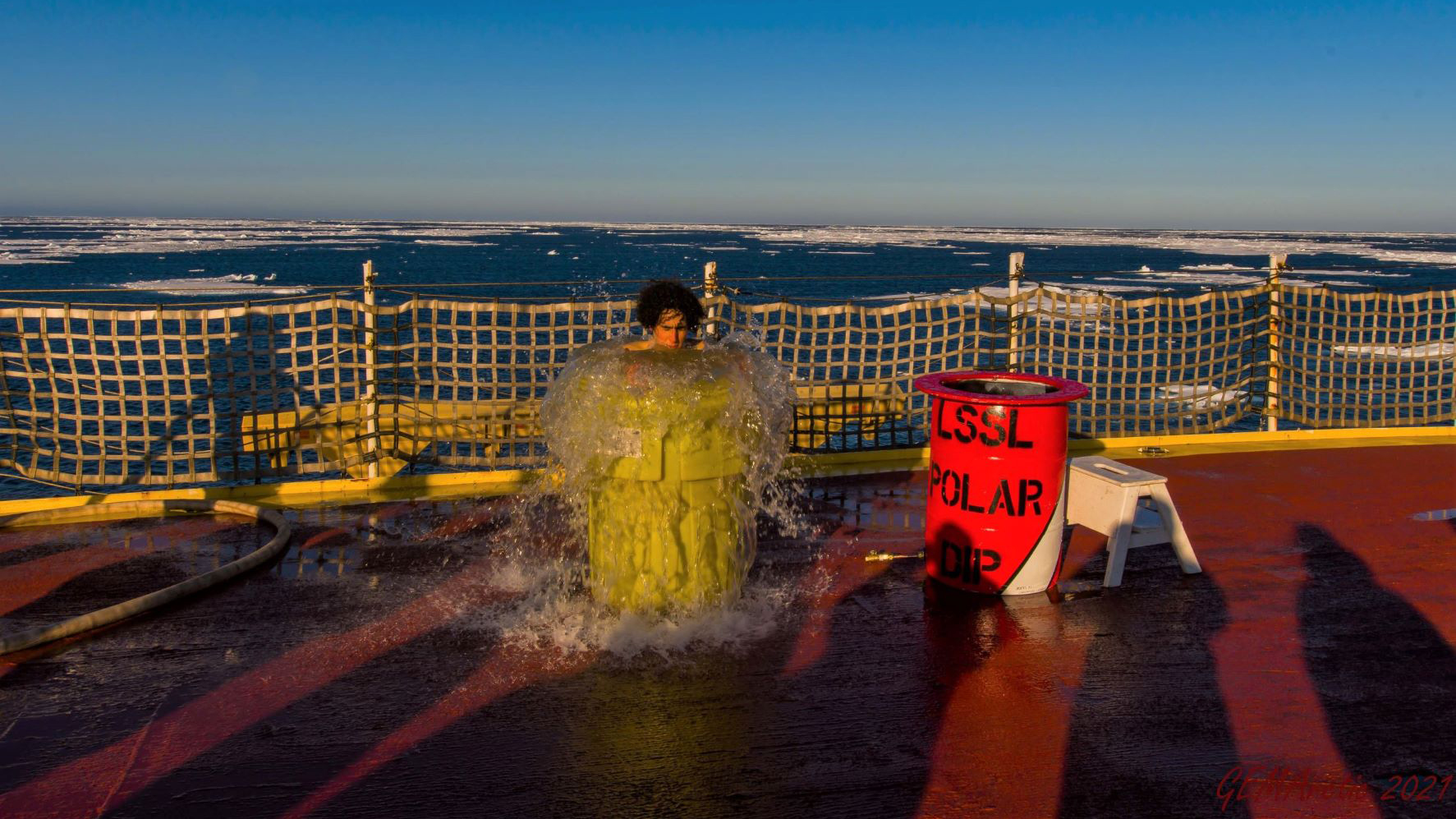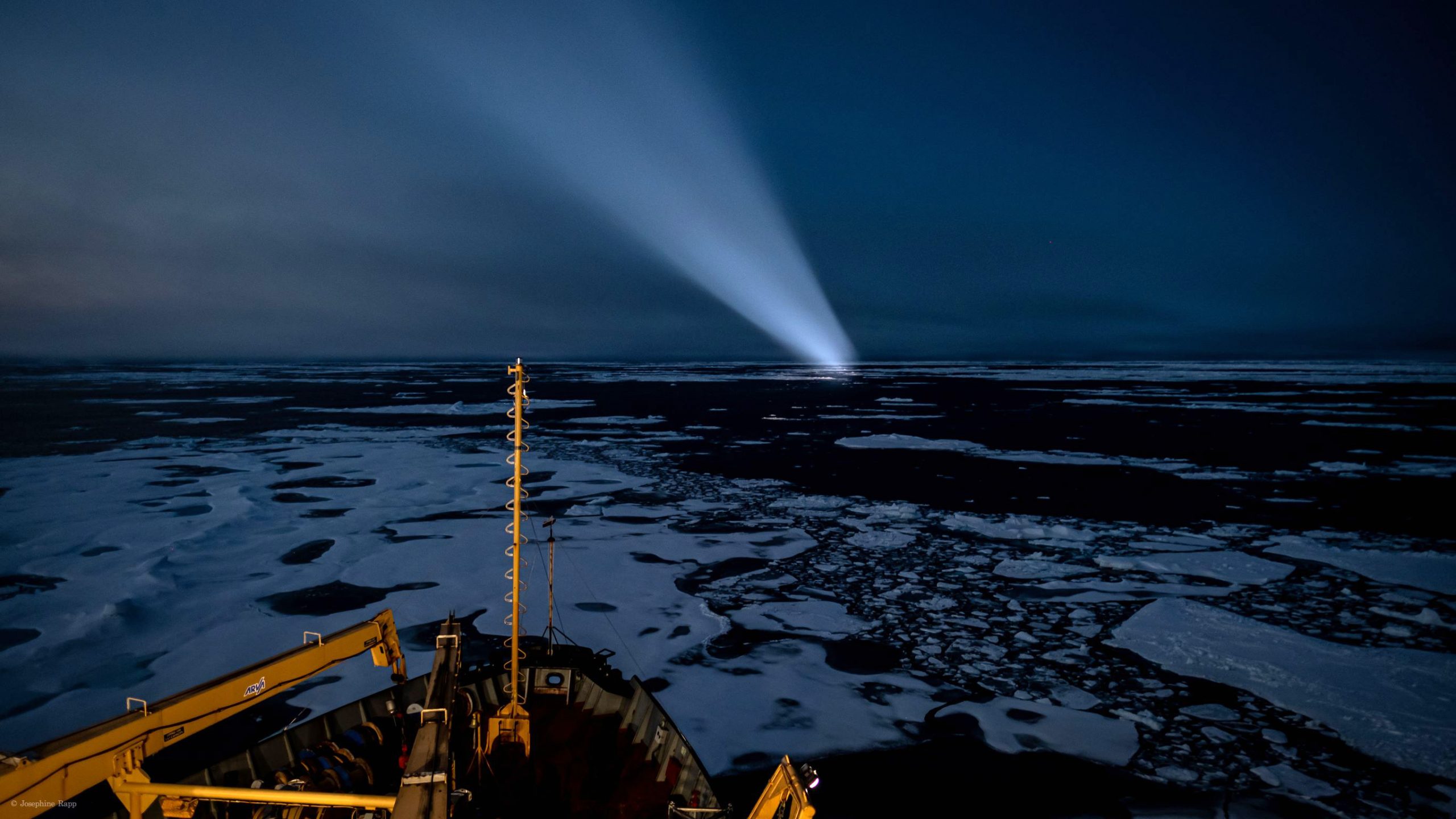2021 Dispatches
Dispatch 1: All Aboard!
Dispatch 2: Science Shakedown
Dispatch 3: Polar Bears and More!
“Attention all crew, attention all crew. Four polar bears on the starboard side.”
Sunday morning was off to a great start as the bridge announced our first major wildlife sighting at 6 a.m. Crewmembers and scientists quickly lined the outer decks, equipped with cameras, binoculars and varying amounts of warm layers. For many, the announcement pulled them directly out of bed, and jackets and hats were haphazardly pulled on while rushing outside. The polar bears moved along the ice in the distance, one rising up to its hind legs to tower over the others.
Dispatch 4: What does the Canadian Coast Guard do in the Arctic?
What does the Louis do when she’s not carrying a bunch of scientists through polar waters? Quite a bit, apparently! Here’s what I learned from Third Mate Alex Missi.
Dispatch 5: Science Plan
There are few vessels capable of transiting in the central Beaufort Gyre, let alone carry out scientific research, so our expedition is packed with science. As we steamed out from Cambridge Bay into the central Beaufort Gyre, we analyzed available sea ice charts and images as well as weather reports to chart a cruise track that optimized our time.
Dispatch 6: Did you know that ice has a birthday?
At 5:30 a.m. every morning, Francis Beaulieu rolls out of bed and fires up the ice forecast computers on the bridge deck. A weather and ice forecast must be ready by 7 a.m. for the Captain’s briefing.
Dispatch 7: Recovery and Redeployment
This year’s science plan includes recovering and redeploying three moorings in the Beaufort Sea. The Woods Hole Oceanographic Institution (WHOI) team was unable to recover the moorings last year due to COVID-19, so the instruments waited in the water for nearly three years instead of the intended two. While the instruments on the mooring have a longer battery life than the planned timeframe (just in case!), extending the deployment by an entire year had everyone holding their breath leading up to the first mooring’s recovery.
Dispatch 8: Sampling at Sea - Dissolved Organic Matter
I am Nicolas Sylvestre, PhD student at the Université de Sherbrooke under the supervision of Dr. Céline Guéguen. This year is the third time that I have had the great opportunity to be part of the JOIS/BGOS expedition in the Canada Basin aboard the CCGS Louis S. St-Laurent. My supervisor Céline and my lab-mate, Mohamed Gamrani from Sherbrooke are also on board for this scientific mission.
Dispatch 9: Field Trip to the Engine Room(s)
If the Louis were a small town, the engine room crew would be its entire public works department. In addition to keeping the ship’s engines and mechanical components running smoothly, the team of 18 engineers, oilers, technicians and electricians also handle the ship’s heating, refrigeration, electricity, water treatment and waste management. If you ask nicely, they sometimes even take curious scientists on a tour through the ship’s engine rooms!
Dispatch 10: A Symphony at Sea
If Anton Dvorak, instead of the New World, had sailed to the Arctic Ocean on the Louis as inspiration for his famous ninth symphony, he might have ended up with a very different piece. Because (let's be honest) the Louis is noisy, and she does not understand the term “harmonics.”
Dispatch 11: Sampling at Sea - Microbial Life
In addition to the physical parameters of the Beaufort Sea, we are also interested in its biological communities. The most visible way JOIS studies life within the Beaufort Sea is without a doubt the “bongo” net casts for zooplankton (the nets look like large bongo drums when hung over the ship’s side), resulting in bizarre-looking crustacean communities gently floating in fixative in the main lab. Less easily observed – but essential for the functioning of the ecosystem – are microbial communities, composed of single-celled plants, bacteria and their viruses.
Dispatch 12: Chasing Ice
Along the northern stretch of our cruise track, our plan was to deploy four ice-based observatories. These included 4 Ice Tethered Profilers (ITPs), 3 Tethered Ocean Profilers (TOPs), 2 Seasonal Ice Mass Balance Buoys (SIMBs), and 1 Arctic Ocean Flux Buoy (AOFB). ITPs measure ocean salinity and temperature along an 800m wire hanging below the sea ice. Two of the ITPs aboard also included oxygen sensors and stationary Submersible Autonomous Moored Instruments for partial pressure of CO2 (SAMI-CO2). TOP is a new profiler designed to bump into the sea ice and measure the near-ice water properties, which the ITP does not measure. SIMBs measure ice and snow thickness, and AOFBs measure under-ice heat and momentum fluxes as well as atmospheric properties. Co-locating multiple platforms allows us to cross-calibrate them and to better understand the full air-ocean-ice system.
Dispatch 13: The Secret Life of Wild Microbes and Viruses in Arctic Sea Ice
The door to the ship’s main lab holds our science note board, which we use to keep everyone updated with the current station planning. When I woke up today it read “Ice stations complete! Congrats!” and – yes - that is a reason to celebrate! My name is Josephine Rapp and I’m a marine microbial ecologist with a focus on the cryosphere. “Cryosphere” is a collective term for environments where most water is present in its frozen state, for example sea ice, glaciers, and permafrost. Even though these environments may appear to be uncomfortable and harsh living spaces, they are home to diverse and abundant small organisms and their viruses.
Dispatch 14: The Final Ice Stations
On September 3rd, we aimed for a vast sea ice floe about eight nautical miles in diameter. We intended to deploy four buoys on this promising floe, dubbed “blueberry pancake,” which seemed likely to be relatively thick as it kept its size through most of the melt season. Unfortunately, it turned out to be thin and slushy. We transited through the floe twice looking for thicker areas but were unsuccessful. We set our course due 15 minutes north of the next CTD station at 78N,140W, hoping to find something suitable before lunch time.
Dispatch 15: All Hands on Deck - Part 1
Step onto the bridge (with permission) and you’ll likely first notice the remarkable view of ice and ocean meeting the clouds. There are no landmarks out here in the Beaufort Sea, and at high latitudes, the sun’s rays stretch the sun’s colors into beautiful shades. A quick look around and you’ll next spot the officer on watch and the quartermaster, maneuvering the ship among a plethora of displays, knobs and switches. Above all, the navigation and deck team ensure the safety of the ship, crew, and equipment.
Dispatch 16: All Hands on Deck - Part 2
While navigation officers, engine room crewmembers, and the galley team mostly gravitate to one area on the ship, the deck team spreads out to do a bit of everything. Their tasks range from fuelling the helicopter to vacuuming the ship’s corridors and assisting with science operations. I’ve seen deckhands painting, salting the decks and shoveling snow. I’ve watched as they moved equipment around with the massive foredeck cranes or winched four kilometers of a mooring out of the ocean. In limited visibility conditions, they may be called to the bridge to assist with watch duties, and at ice stations, they’re on the lookout for polar bears. Our CTD rosette casts, “bongo” nets and mooring operations would not be possible without the deck team.
Dispatch 17: Mooring D
As we crashed our way to mooring D, it became clear that this was not going to be an easy mooring recovery. All around us was the most concentrated and most uneven ice we had seen all trip! Thick ridges of old ice were wedged between thin sheets riddled with deep blue melt ponds causing the Louis to jolt at every encounter.
Dispatch 18: Fuel for the Crew
Just as the engine room is the powerhouse of the ship, the galley team is the powerhouse of the crew. And exactly like the engines, they never seem to stop. The Louis’ four cooks and five stewards are constantly on the go, planning, preparing, and serving meals for everyone aboard. Even when the rest of the ship stops active operations in high seas, the galley carries on.
Dispatch 19: Ready for Takeoff
Strapped to the deck with its rotor blades neatly folded away, the Louis’ bright red and white helicopter patiently waits for its next mission. The hangar’s tall ceilings and sparse walls amplify the wind rattling the two garage doors as Flight Engineer, Jacques Lefort walks us through this unique part of the ship’s operations.
Dispatch 20: From Allergy to X-Ray - Medical Emergencies at Sea
A few years ago, I took a Wilderness First Aid (WFA) course in my hometown, Victoria, B.C. The WFA certification differs from Standard First Aid mainly in that you cannot assume an ambulance will arrive within minutes. In addition to CPR, spinal injuries, and the classic first aid techniques, we learned to build shelters and splints out of tree branches and bandages out of rain pants. The most important takeaway: you’re on your own, so be prepared for anything.
Dispatch 21: Sampling at Sea - The CTD Rosette
“Delivery for Marty!” My bright yellow overalls swish together as I carry yet another green shopping basket of seawater samples from the CTD rosette to the labs. We are now sampling along the “MK Line,” moving quickly towards the Mackenzie River outflow. The CTD rosette stations are getting shallower and closer together (the last station is only 60 meters deep!), and the Louis’ labs seem busier than usual as we wrap up our last few science stations on this trip.
Dispatch 22: Observations, Projections, and Modelling
Let’s start with the obvious: the ocean is a complex system. And it is important – arguably the most important component of the climate system, storing a third to a half of the anthropogenic CO2 and 90 percent of the associated heat. Now, add a layer of ice on top of it, and you get a very complex system. A system you cannot observe remotely via satellite, as is done for the rest of the ocean. A system you cannot reach without highly specialized ships, such as our illustrious Louis. (And even then, several months of the year are out of the picture, hence the moorings and ITPs that the Woods Hole team put so much effort in to deploy.) But there is another tool at our disposal: numerical modelling.
Dispatch 23: Bingo, Tournaments, and Feasts
Today marks the last science day in the 19th year of the JOIS-BGOS program. Chief Scientist Sarah Zimmermann, added a last-minute surprise rosette station (because you can never have too much science) in the Amundsen Gulf this morning on our way back to Cambridge Bay, but suddenly, we were done. Over 25 science days, we recovered, refurbished, and redeployed three moorings; completed four ice stations, 34 bongo net tows, and 57 CTD rosette casts; picked up two ITP ice buoys and deployed 53 XCTDs as we crisscrossed the Beaufort Sea. We collected over 7,500 seawater samples! But it wasn’t all work and no play: a series of games, tournaments, and side projects kept everyone busy in our spare time. And what better way to celebrate the completion of another year of successful science stations than by roasting an entire pig?
Dispatch 24: Goodbye Louis!
And just like that, it was time to go home.
After 28 days at sea, the Louis had arrived back in Cambridge Bay. The last few days were full of packing, cleaning, end-of-cruise reports, and endless inventory lists as the entire crew prepared for our departure.
